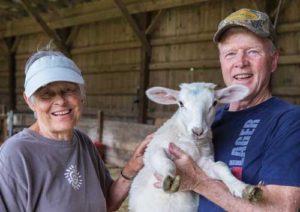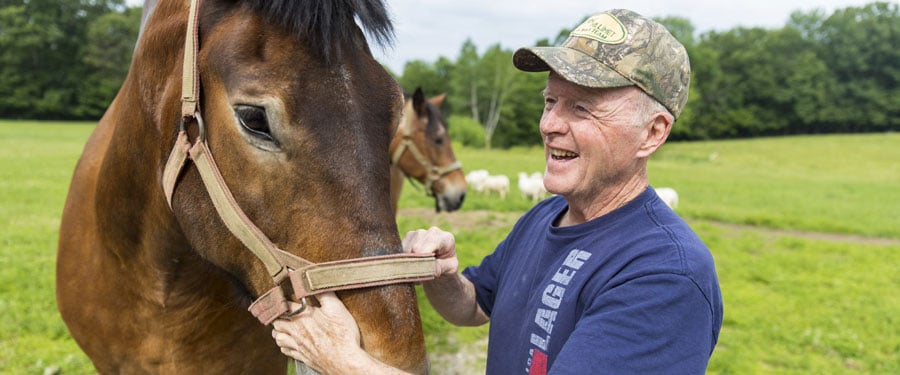Written by David Johnson
Photos by Jerry Monkman
"We need to get our farming practices integrated with nature. I don’t want to try and beat nature. I want to work with it. The better I can mimic the natural world, the better the farm will do.” - Jack Clarke
For Jack Clarke, it’s all about the dirt. The soil just under the surface, that layer that serves as the handshake between the farmer and the environment. When you peel that back, when you dig a little deeper – as Jack has, painstakingly, for so many years – you learn something.
It is a simple lesson on the face of it, but in practice it takes a lifetime to master: don’t try to control nature.
It is a bright spring day as Jack relays his knowledge, a pleasant afternoon at Clarke Farm, a revered livestock operation in Epping and Newmarket that is so picturesque it looks like it slid off of a postcard.
A 360 degree look around the farm is all the proof you need of Jack’s concept; everywhere within sight of the naked eye sprawls lush, green pastures and, nearby, a flock of sheep and herd of beef cattle are grazing. It is a testament to the symbiosis that Jack espouses.
Of course, it wasn’t always like that. When Jack first set foot on this acreage, it was not the swathes of emerald green grass it is today. It was woods, thick and knotty and overgrown.

When Jack first moved to the property he had his work cut out for him – and that work was, literally, cutting. During the winter of 1981, while he and his wife Linda lived in a mobile home across the road, Jack began the painstaking process of clearing the woods and laying the groundwork for his pastures – and the new Clarke homestead.
For Linda, who grew up a city girl in Lawrence, MA, the farm experience was brand new, but she took to it. And Jack was grateful for that; operating this farm would be more than one person could handle.
“I couldn’t do what I did if I didn’t have her support,” Jack says. “She loves the farm as much as I do and she’s just as committed to it. What was important is that we did it together.”
Eventually, the trees were cleared, a farmhouse house was built, and, together, Jack and Linda were ready to grow. However, little did Jack know at that time – he still had a lot to learn.
A NEW APPROACH
This idea of working in concert with nature was not what Jack originally subscribed to. Coming out of the post-WWII era, chemicals became the de facto tool of the trade in the agricultural industry. Through the early 1990s, Jack farmed “conventionally” as he termed it; that is, utilizing herbicides, fossil fuel fertilizers, and other chemical “control” agents.
“I did do some reading on organic farming, but I didn’t believe it at first,” he says. “I met some farmers who farmed in a natural state, and in conversations with them I learned about what they did and how they did it and why they did. It started to register with me.”
What is “it?” Simple: Jack was no longer going to try and bend nature to his will; he was ready to start working in concert with it, to mimic it.
“The more observations that I made of my approach and what my results were, the synapses finally connected,” he says, laughing to himself. “I realized how incredibly stupid I’ve been. I understood how I needed to work with nature to help me do what I needed to do.”
As nice as it would be, narrative-wise, to say that Jack had a singular Eureka! moment – perhaps, a bright ray of sun broke through the clouds one day to bathe some tilled soil in an ethereal goal – as is the case with farming overall, it was a process. A long process of learning and trying and failing and sweating. But Jack got there and he fundamentally altered how he worked the land – which cascaded upward, all the way to his livestock, yielding the kind of meat that has become legendary in the region for its taste and nutrition.
“We need to get our farming practices integrated with nature. I don’t want to try and beat nature. I want to work with it. The better I can mimic the natural world, the better the farm will do.”
But first, let’s return to the dirt.
Right off, you should know: this whole thing is an empirical pursuit. Gut feelings don’t govern how soil is enriched; this is craft, not art. Which fits Jack Clarke’s left brain wiring (for many years, Jack’s non-agriculture day job was in the financial industry). He starts at the atomic level with his soil, testing it to get a baseline of its pH level, the mineral constitution, and the all-important calcium ratio (which New England is deficit in, thanks to a dearth of limestone).
Clarke Farm is dominated by sandy loam, so Jack knew he needed to build up the organic matter in the soil and generate a robust infusion of minerals. That means loads of organic matter and compost (e.g., kale, winter rye, fish emulsion, and good old-fashioned cow poop) spread across his acreage. And then, when it’s time to till, don’t overdo it! Keep it below the one-inch depth threshold.
“Deep tilling exposes the soil to air and releases carbon,” Jack says. “And now all the work you’ve done to put organic matter into the ground, you’re going to lose it. If I’m going to harvest minerals from that soil, then I have to make sure they’ve been replaced.”
So why all of this effort to get the dirt just right? Because you can draw a straight, chisel-tip Sharpie marker line from the quality of the soil to the quality of the meat. Healthy animals that have ingested the best minerals translates to top-shelf eating, and Jack looks to the soil to be the delivery system for the premium nutritional value his sheep and cattle crave. Jack supplements the grass and hay that comes from his own fields with things like kelp, which backfills mineral deficiencies.
“There is no such thing as a ‘dumb animal,’” Jack says. “They know when they need something, and they intuitively know that they can go out and get that something that will help them from the soil.”
“You can’t just like farming. You have to love it.”
The Clarke Farm herds graze in a rotation, moving from pasture to pasture (and simultaneously fertilizing the parcels in their own special way). Jack keeps a keen eye on the grazing paddocks as well, making sure to move
the animals to the next patch before the grass is taken too far down and risking the painstakingly cultivated root mass (“There’s a direct relationship with the root mass in the ground and the crop above the ground,” he says).
The upshot to all this complexity?
“My animals don’t get sick,” he says. “One of the biggest things I found when I changed to organic farming is that my vet bill went away.”
And healthy animals means healthy – and delicious – meat.
“It’s higher quality,” he says. “You have more Omega 3s, more amino acids in the meat. The blood profile of my beef cattle is similar to salmon or chicken!”
Unsurprisingly, Jack Clarke’s yields are in high-demand. Though he is often approached by restaurants and retail outlets looking to buy, Jack instead points his business towards families, who make up 95% of his business. Word of mouth (more like word of mouth-watering?) takes care of all the marketing Jack has ever needed.
“I have a website,” Jack says. “But I never visit it. I just love farming. I love being outside and doing what I do.”
THE FARM, EVERGREEN

“There are so many reasons why conserving this property is important, but the heart of why we’re doing this is to protect our local farms and our ability to produce food here in New Hampshire,” says Jeremy Lougee, Conservation Project Manager and Farmland Coordinator for SELT. “One of the many things we’ve learned from this pandemic is the fragility of our food supply. When the grocery stores run out, it becomes easier to see just how important our local farms and farmers really are.”
“It means an awful lot for Linda and me,” Jack says. “We really want to see land preserved in a way that can be productive and serve the interest of society in providing healthy food. For us it’s all about the quality of what we do and what we deliver.”
The day is almost over on Clarke Farm. The late afternoon whispers of dusk begin to swirl and the animals settle in for the evening. Jack, in his polite, agreeable nature, walks and talks all the way to the parking area, offering his parting thought on a farming life that has never been easy, but has always been fulfilling.
He says: “You can’t just like farming. You have to love it.”
And then, suddenly, a great blue heron flies overhead, its destination the pond that sits in one of his fields. Jack’s face lights up at the sight. He says, grinning: “Those are the little things that make farming worth it.”


